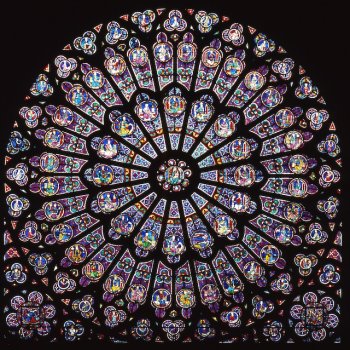We arrived around lunchtime, and Judy and I decided to begin our exploration of medieval architecture with a much more modern meal: kebabs. We love it, no matter what the name: kebab, gyro, döner... Keep it coming.

After lunch, we headed over to the cathedral, officially called Notre-Dame de Chartres because it was (and I guess still is!) dedicated to adoration of the Virgin Mary. Pilgrims came (and I guess still come!) to see a special relic of the Virgin--a piece of her veil.
It's a masterpiece.
Our tour guide, a remarkably entertaining Brit named Malcolm Miller, who literally wrote the book on Chartres Cathedral, was terribly interesting and insightful. Before visiting the church, we read an Ensign article by Jack Welch on the mise ensemble in one of the Chartres windows (which are by the way world-renowned for their vibrant and irreplecable blue) of the story of the Fall of Adam and the parable of the Good Samaritan. Dr. Welch and Mr. Miller explained that in the Middle Ages, theologians read the parable as an illustration of the fall of man, Christ's rescue, His entrusting humanity to the Church, and then His promise to return. Really, read the article. It's excellent.
The tour of the Cathedral opened my eyes to more than just vibrant colors and medieval theology. I realized (again, this actually happens quite often) that my own culture and upbringing and religious background and historical context mean that I'm blinded to things that would be obvious to others. For example, when I look at stained glass windows, I mostly see beautiful patterns of light and maybe, with help, the story the glass is trying to tell. However, I miss the deep, rich symbolism that would have been second nature to a 13th century pilgrim. Being at Chartres--and further, being in a new culture period--makes me realize again what Clifford Geertz explains in his article "Religion as a Cultural System": religion (and this thing we call CULTURE itself) is
(1) a system of symbols
(2) which acts to establish powerful, pervasive and long-lasting moods and motivations in men
(3) by formulating conceptions of a general order of existence and
(4) clothing these conceptions with such an aura of factuality that
(5) the moods and motivations seem uniquely realistic.
I don't care to explain all of that in great depth, and if you care to read it, the article is on GoogleScholar somewhere. What I'm getting at is this "uniquely realistic" thing. One CULTURE is transparent to those who live within it, but another CULTURE is illegible to outsiders. I don't look at stained glass windows the same way a 13th century pilgrim would because what for him is obvious (or "uniquely realistic"), is hidden to me, who doesn't understand the culture, the symbols, and the theology that surround their interpretation.
Also, credit goes again to Dr. Hurlbut for introducing Clifford Geertz into my life. Thank you, Sensei.
It occurs to me now that I should post some of the pictures I took at Chartres, but like I said about Sainte-Chapelle, you really just need to go have a look yourself. The Cathedral is enormous and beautiful and awe-inspiring.




Go! It's beautiful! But get a tour from Malcolm Miller. Truly an insightful experience.









